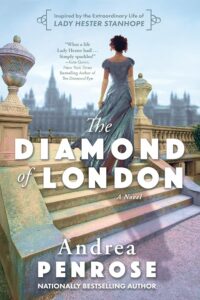 Andrea Penrose has a long series of historical mysteries, but here she pivots to straight historical fiction, illuminating the life of Lady Hester Stanhope, who lived during the Regency period in England. After her mother, who was related to the powerful Pitt family, died young, she was left with an eccentric father and the responsibility for three stepbrothers. Hester spent much of her young adult life with her grandmother, Lady Chatham, and a bit later served as hostess and secretary to her uncle, William Pitt, who served as Prime Minister.
Andrea Penrose has a long series of historical mysteries, but here she pivots to straight historical fiction, illuminating the life of Lady Hester Stanhope, who lived during the Regency period in England. After her mother, who was related to the powerful Pitt family, died young, she was left with an eccentric father and the responsibility for three stepbrothers. Hester spent much of her young adult life with her grandmother, Lady Chatham, and a bit later served as hostess and secretary to her uncle, William Pitt, who served as Prime Minister.
One of the things I truly enjoy about historical fiction is “meeting” a real person who I would have otherwise known nothing about, most of them women. Hester was fated to be an outlier in her own family story, eternally scrambling for a place to live and a means to live her life. Instrumental in supporting and championing her, her uncle was more like as a father to her than her actual one.
As portrayed by Penrose (and backed up by history), Hester was a strong, fearless character who wanted to live life on her own terms and chafed at the restrictions placed on women, particularly in the form of marriage. While she was associated with some famous and well placed men, including Beau Brummel, she resisted the legal snare of matrimony. Adding to her anxieties is her social enemy, Georgina Spencer, the infamous Duchess of Devonshire.
Penrose does a wonderful job of portraying both politics and society and is especially adept at recreating the atmosphere of balls and the kind of malicious backstage gossip that was traded at similar social events. The cast remained the same in most instances, so these were people who both encountered one another often and were uncomfortably familiar with each other’s backgrounds and family history.
Hester’s involvement with her rakish and scandalous cousin Thomas Pitt, Baron Camelford, a man who matches Hester’s lust for life and embrace of danger and adventure, leads to some low level scandal and gossip. The two together were, as this book suggests, a flammable combination, and they were both singed by it. As she eases out of this toxic relationship and finds herself enjoying her work for her uncle, she strikes up another relationship with the more acceptable Earl of Granville, known as the “most beautiful man in London.”
While this connection is documented, as well as Hester’s reaction to their breakup, her relationship with the most acceptable of all General Moore is not as well verified. Although from their correspondence it appears they were considering marriage, the General was killed before that could happen. Penrose takes slightly anachronistic liberty with her portrayal of Hester as sexually active, unremarkable in the world of today, but not a socially acceptable form of behavior for a woman in her own time.
After her many life losses, Hester’s life breaks apart and she heads to the continent, becoming a well-known adventurer, traveler, and scholar. Penrose is more concerned with her journey to reach that point, fleshing out the bare facts with her portrayal of Hester’s emotional life. I enjoyed meeting this woman and appreciated a look at an unknown (to me) slice of history. — Robin Agnew